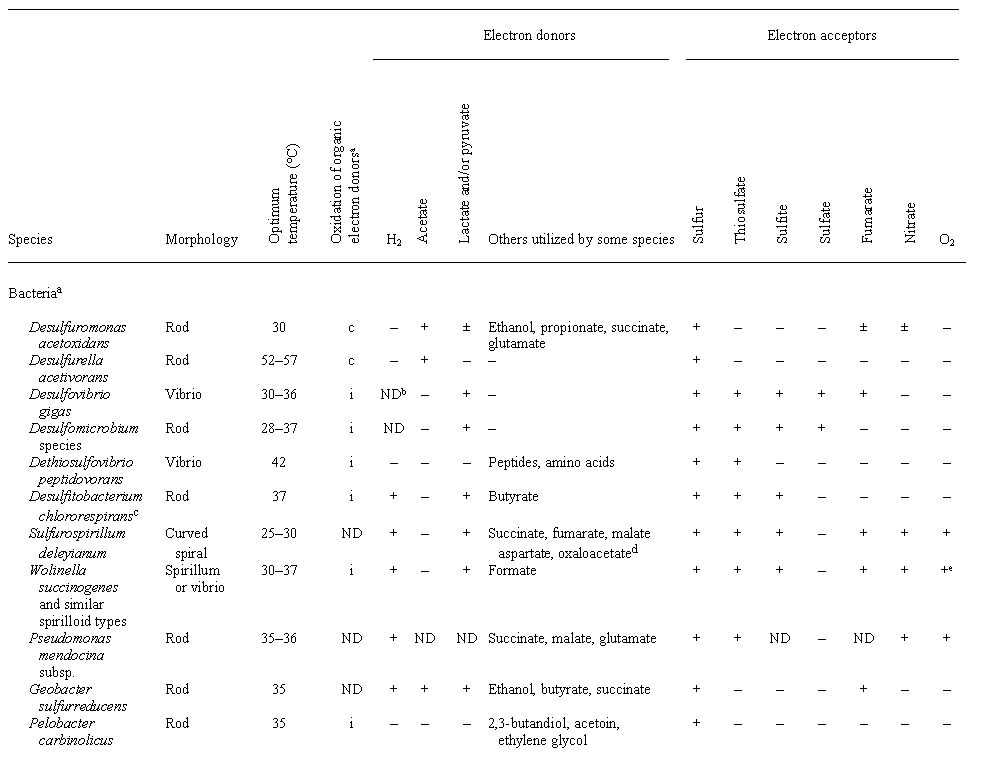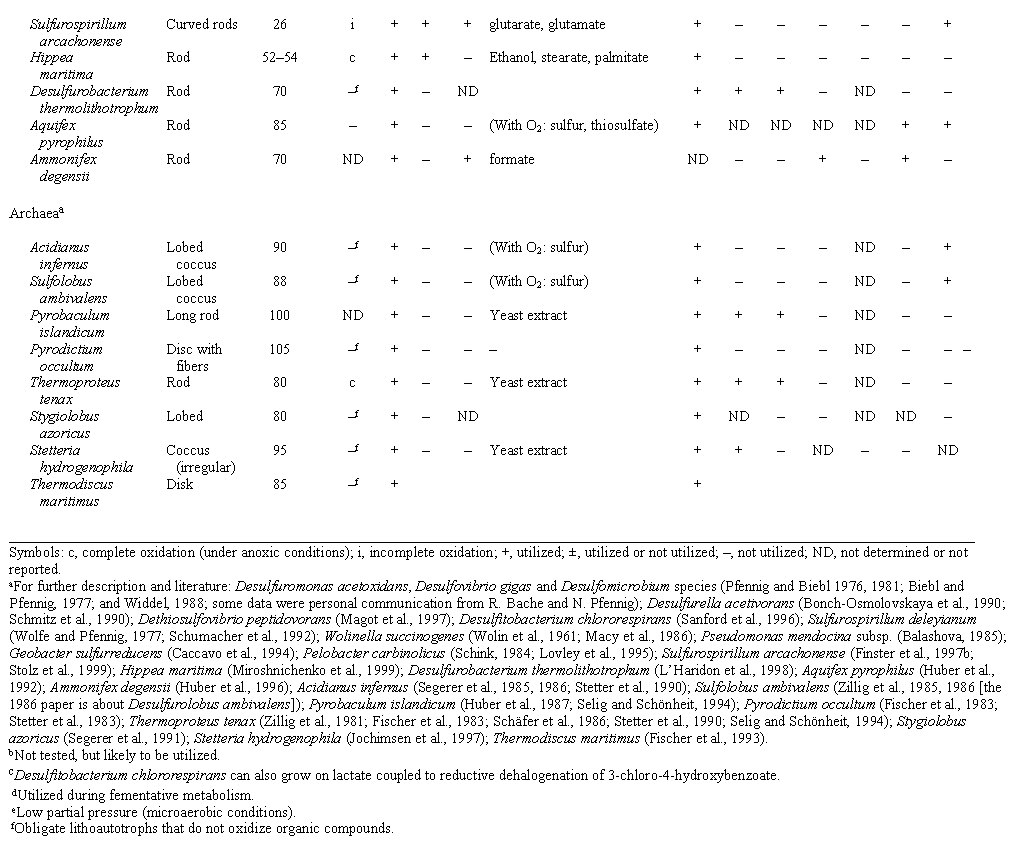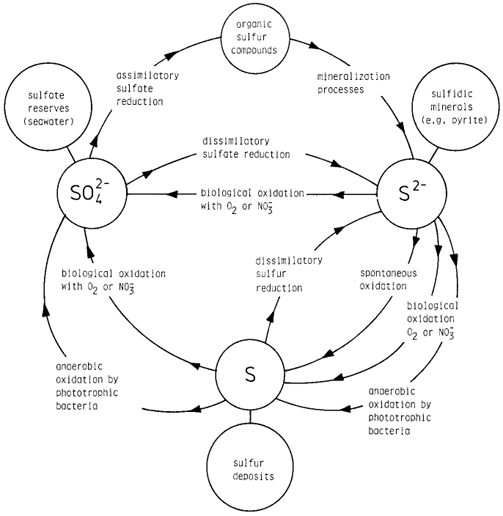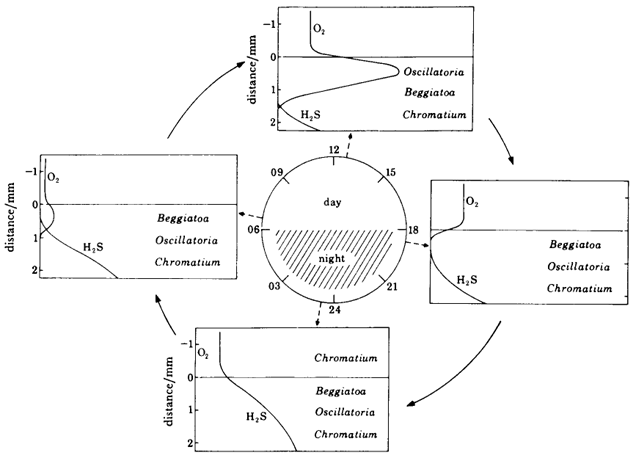


Organisms that use H2S or other sulfides
Electron acceptor: oxygen, or in some special cases nitrate
Ecosystems: marine/freshwater soils, sediments at the interface of oxygen and H2S; treatment plants; usually in close association with sulfate reducers; in symbiosis at hydrothermal vents in with various euks
Phylogenetic Distribution: Some archaea, species in all groups of proteobacter, most are aerobic, a few are anaerobic using nitrogen oxides (nitrate). The metabolic capacity for sulfide oxidation belies the diversity of pathways that the organisms exhibit. This is considered to be convergent evolution.
The most important properties that determine the development and distribution of phototrophic bacteria in nature are the availability of light, the light intensity, and the concentrations of sulfide and oxygen, which form countercurrent gradients in most of the natural habitats of purple sulfur bacteria where sulfide is produced by biological sulfate reduction. The depth at which phototrophic sulfur bacteria develop is largely restricted to the concomitant presence of light and sulfide. Some of the microbial activities that determine slope and position of these gradients, such as oxygen production by algae and cyanobacteria and sulfide oxidation by phototrophic bacteria, show diurnal, light-dependent fluctuations. Others, such as sulfide production by sulfate-reducing bacteria and oxygen consumption by respiratory bacteria, do not. Because of these processes, the sulfide horizon rises at night and falls again during the day. The motile phototrophic purple bacteria are able to follow the moving sulfide horizon.
Green sulfur bacteria and Ectothiorhodospiraceae exhibit 5 to 7 times higher affinities for sulfide than Chromatiaceae (van Gemerden and Mas, 1995). On the contrary, affinities for polysulfides are comparable between green sulfur bacteria and Chromatiaceae.
Authors for Literature Searches: Lesley Robertson, J. Gijs Kuenen

Model of a marine sulfuretum (a microbial mat in which the total turnover of inorganic and organic compounds is heavily dominated by the sulfur cycle)
 Diurnal cycle of oxygen
and sulfide distribution and of microbial zonation in a marine sulfuretum.
The zero line in each box indicates the interface between the sediment and
the overlaying water phase. The dominant genera at each stratum are indicated
in each box. Diatoms were primarily seen among the Oscillatoria. In addition
to diurnal changes in light, oxygen, and sulfide, another important factor
was that the Beggiatoa which are gliding bacteria could not move out of the
sediment, whereas Chromatium, which is also motile, was able to move into
the water phase above. From Jørgensen (1982). It was observed that
the mixture of cyanobacteria, phototrophic sulfur bacteria, and Beggiatoa
was stratified, and that the relative positions of the the three populations
among the strata were governed by the level of photosynthetically generated
oxygen. During the night, when the oxygen had been depleted and the oxygen
boundary extended to the surface of the sediment, the phototrophic Chromatium
was found at the surface. However, once photosynthesis began, with the onset
of daylight, oxygen began to build up in the sediment, and the Chromatium
followed the sulfide boundary down, remaining within the anaerobic part of
the sediment. The Beggiatoa population tended to move with the sulfide:oxygen
interface, except during the night when this was in the stagnant water above
the surface of the sediment. As Beggiatoa is only motile by means of a gliding
action, it is restricted to the solid phase.
Diurnal cycle of oxygen
and sulfide distribution and of microbial zonation in a marine sulfuretum.
The zero line in each box indicates the interface between the sediment and
the overlaying water phase. The dominant genera at each stratum are indicated
in each box. Diatoms were primarily seen among the Oscillatoria. In addition
to diurnal changes in light, oxygen, and sulfide, another important factor
was that the Beggiatoa which are gliding bacteria could not move out of the
sediment, whereas Chromatium, which is also motile, was able to move into
the water phase above. From Jørgensen (1982). It was observed that
the mixture of cyanobacteria, phototrophic sulfur bacteria, and Beggiatoa
was stratified, and that the relative positions of the the three populations
among the strata were governed by the level of photosynthetically generated
oxygen. During the night, when the oxygen had been depleted and the oxygen
boundary extended to the surface of the sediment, the phototrophic Chromatium
was found at the surface. However, once photosynthesis began, with the onset
of daylight, oxygen began to build up in the sediment, and the Chromatium
followed the sulfide boundary down, remaining within the anaerobic part of
the sediment. The Beggiatoa population tended to move with the sulfide:oxygen
interface, except during the night when this was in the stagnant water above
the surface of the sediment. As Beggiatoa is only motile by means of a gliding
action, it is restricted to the solid phase.
Beggiatoa, gamma proteobacter, nitrogen fixer, fliding colorless, S8 globules inside membrane inclucsion (periplasmic), gram negative, but with strange cell wall, chemotactic.
Oscillatoria - cyanobacteria, non nitrogen fixing
Chromatium - purple sulfur (along with Ectothiorhodospiraceae), anoxygenic photosynthesizers (PSII), electron donor is sulfide, which is oxidized to sulfate via intermediate accumulation of elemental sulfur inside the cells, need quiet water, fresh and marine, sea ice; nitrogen fixation is linked to hydrozen production; motile and follow the moving sulfide horizon that rises at night
Green sulfur (deeper water, sediments, , purple non-sulfur, and Ectothiorhodospiraceae (high salt, soda lakes) deposit S8 outside the cell